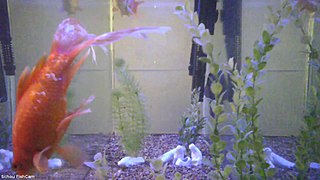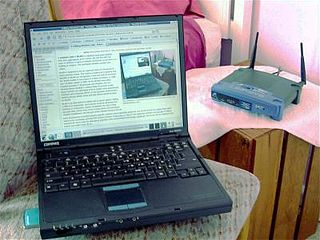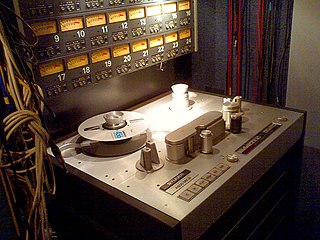ABC are the first three letters of the Latin script known as the alphabet.

In computer networking, multicast is group communication where data transmission is addressed to a group of destination computers simultaneously. Multicast can be one-to-many or many-to-many distribution. Multicast should not be confused with physical layer point-to-multipoint communication.

Streaming media is multimedia that is constantly received by and presented to an end-user while being delivered by a provider. The verb "to stream" refers to the process of delivering or obtaining media in this manner; the term refers to the delivery method of the medium, rather than the medium itself, and is an alternative to file downloading, a process in which the end-user obtains the entire file for the content before watching or listening to it.

A wireless LAN (WLAN) is a wireless computer network that links two or more devices using wireless communication to form a local area network (LAN) within a limited area such as a home, school, computer laboratory, campus, or office building. This gives users the ability to move around within the area and remain connected to the network. Through a gateway, a WLAN can also provide a connection to the wider Internet.
In telecommunications, a link is a communication channel that connects two or more devices. The link may be a dedicated physical link or a logical link that uses one or more physical links or shares a physical link with other telecommunications links.

In computing, a server is a computer program or a device that provides functionality for other programs or devices, called "clients". This architecture is called the client–server model, and a single overall computation is distributed across multiple processes or devices. Servers can provide various functionalities, often called "services", such as sharing data or resources among multiple clients, or performing computation for a client. A single server can serve multiple clients, and a single client can use multiple servers. A client process may run on the same device or may connect over a network to a server on a different device. Typical servers are database servers, file servers, mail servers, print servers, web servers, game servers, and application servers.

Shortwave radio is radio transmission using shortwave radio frequencies. There is no official definition of the band, but the range always includes all of the high frequency band (HF), and generally extends from 3–30 MHz ; above the medium frequency band (MF), to the end of the HF band.

iLife is a software suite for macOS and iOS developed by Apple Inc. It consists of various programs for media creation, organization, editing and publishing. It comprised: iTunes, iMovie, iPhoto, iDVD, iWeb and GarageBand. Only iMovie and GarageBand remain and are sold separately on Apple's Mac App Store. iDVD and iWeb have been discontinued and iPhoto has been succeeded by Photos.
Homebrewing refers to small-scale, non-commercial manufacture of drink, typically beer.
Code of Federal Regulations, Title 47, Part 15 is an oft-quoted part of Federal Communications Commission (FCC) rules and regulations regarding unlicensed transmissions. It is a part of Title 47 of the Code of Federal Regulations (CFR), and regulates everything from spurious emissions to unlicensed low-power broadcasting. Nearly every electronics device sold inside the United States radiates unintentional emissions, and must be reviewed to comply with Part 15 before it can be advertised or sold in the US market.

Group Policy is a feature of the Microsoft Windows NT family of operating systems that controls the working environment of user accounts and computer accounts. Group Policy provides centralized management and configuration of operating systems, applications, and users' settings in an Active Directory environment. A set of Group Policy configurations is called a Group Policy Object (GPO). A version of Group Policy called Local Group Policy allows Group Policy Object management without Active Directory on standalone computers.

Studer is a formerly Swiss designer and manufacturer of audio equipment for recording studios and broadcasters. The company was founded in Zürich, Switzerland, in 1948 by Willi Studer. It initially became known in the 1950s for its professional tape recorders. In the 1990s the company moved into the manufacture of mixing consoles.

In computer networking, telecommunication and information theory, broadcasting is a method of transferring a message to all recipients simultaneously. Broadcasting can be performed as a high-level operation in a program, for example, broadcasting in Message Passing Interface, or it may be a low-level networking operation, for example broadcasting on Ethernet.
A users' group is a type of club focused on the use of a particular technology, usually computer-related.
The Toronto PET Users Group is one of the world's oldest extant computer user groups, and was among the very largest. The non-profit group is based in Toronto but has an international membership. It supports nearly all Commodore computers, including the PET, VIC-20, C64, C128, Plus/4, C16, C65, and Amiga, including the COMAL, CP/M and GEOS environments. TPUG is noted for its ties with Commodore Canada, its extensive and widely distributed software library, and its association with prominent computing pioneers such as Jim Butterfield, Brad Templeton, Karl Hildon, and Steve Punter.

MTV Flux was a television channel in the United Kingdom and Ireland. The version in the UK and Ireland launched on 6 September 2006. The brand started as a website on 1 August. It used bandwidth that was originally used to broadcast VH2. There is an MTV 'Flux' channel in Japan, which launched in 2007.

Stickam was a live-streaming video website that launched in 2005. Stickam featured user-submitted pictures, audio, video, and most prominently, live streaming video chat. The site quickly expanded to include live shows and produced content from MTV, G4 TV, CBS Radio, NATPE, CES, and many others, as well as live performances and shows with numerous musicians and celebrities.

A free-to-air or FTA Receiver is a satellite television receiver designed to receive unencrypted broadcasts. Modern decoders are typically compliant with the MPEG-2/DVB-S and more recently the MPEG-4/DVB-S2 standard for digital television, while older FTA receivers relied on analog satellite transmissions which have declined rapidly in recent years.

Radio is the technology of signaling and communicating using radio waves. Radio waves are electromagnetic waves of frequency between 30 hertz (Hz) and 300 gigahertz (GHz). They are generated by an electronic device called a transmitter connected to an antenna which radiates the waves, and received by a radio receiver connected to another antenna. Radio is very widely used in modern technology, in radio communication, radar, radio navigation, remote control, remote sensing and other applications. In radio communication, used in radio and television broadcasting, cell phones, two-way radios, wireless networking and satellite communication among numerous other uses, radio waves are used to carry information across space from a transmitter to a receiver, by modulating the radio signal in the transmitter. In radar, used to locate and track objects like aircraft, ships, spacecraft and missiles, a beam of radio waves emitted by a radar transmitter reflects off the target object, and the reflected waves reveal the object's location. In radio navigation systems such as GPS and VOR, a mobile receiver receives radio signals from navigational radio beacons whose position is known, and by precisely measuring the arrival time of the radio waves the receiver can calculate its position on Earth. In wireless radio remote control devices like drones, garage door openers, and keyless entry systems, radio signals transmitted from a controller device control the actions of a remote device.

The British Broadcasting Corporation Microcomputer System, or BBC Micro, is a series of microcomputers and associated peripherals designed and built by the Acorn Computer company in the 1980s for the BBC Computer Literacy Project, operated by the British Broadcasting Corporation. Designed with an emphasis on education, it was notable for its ruggedness, expandability, and the quality of its operating system. An accompanying 1982 television series, The Computer Programme, featuring Chris Serle learning to use the machine, was broadcast on BBC2.













